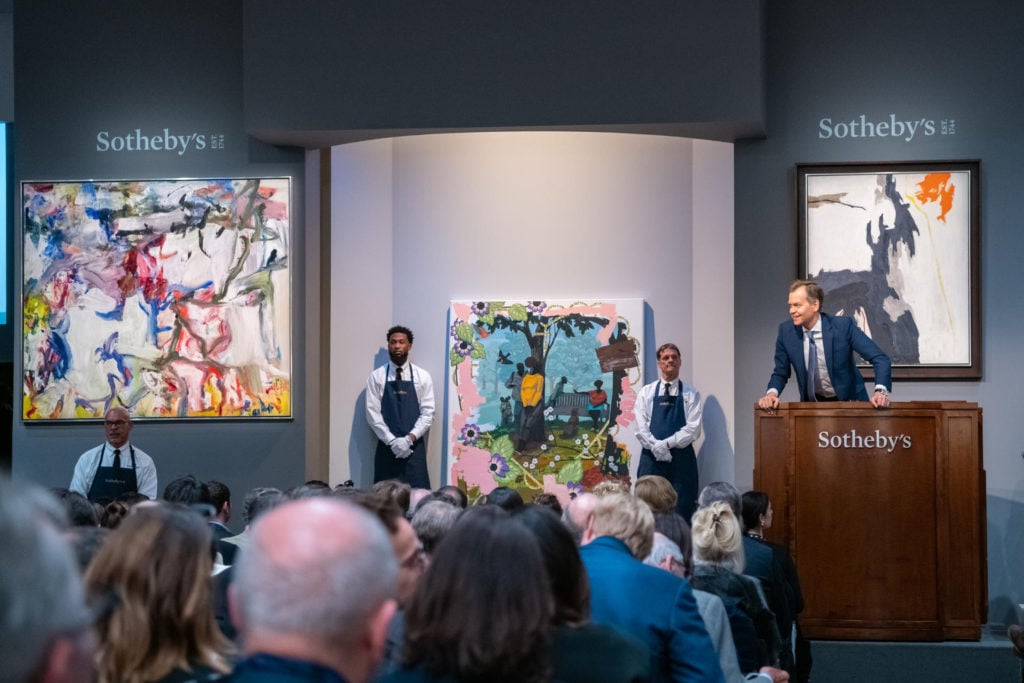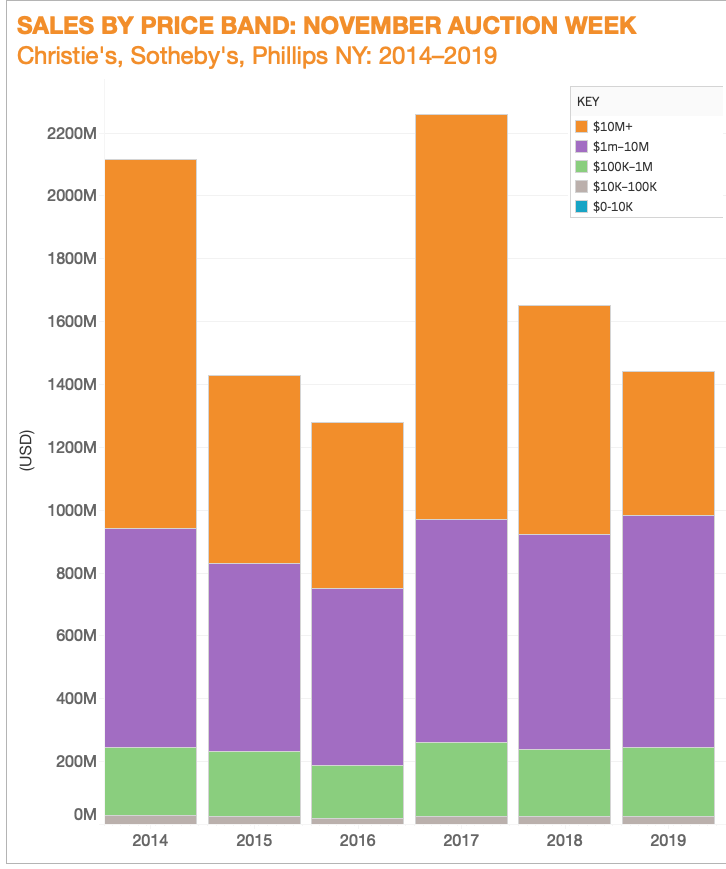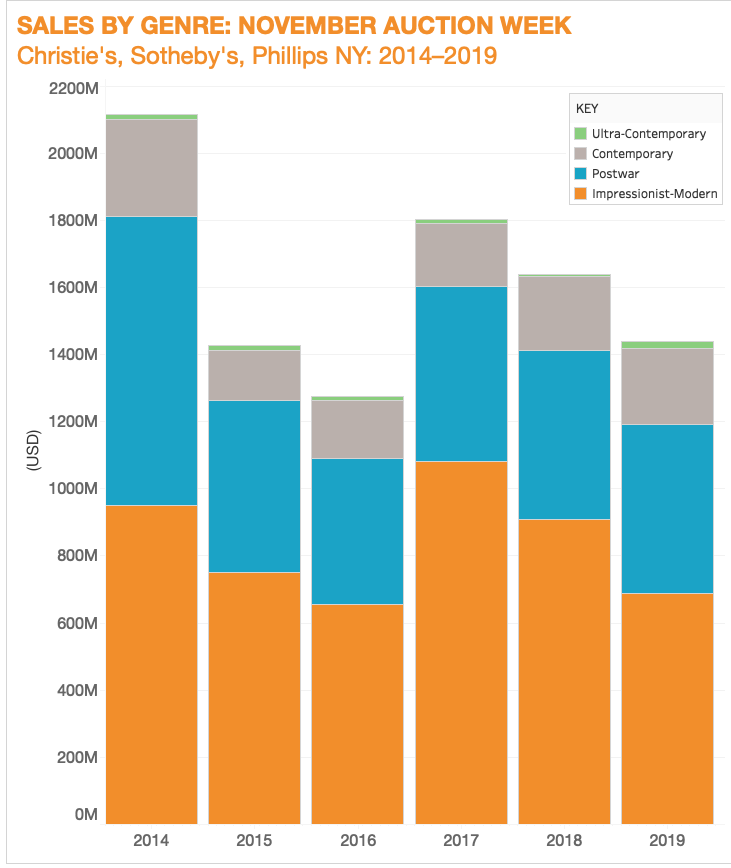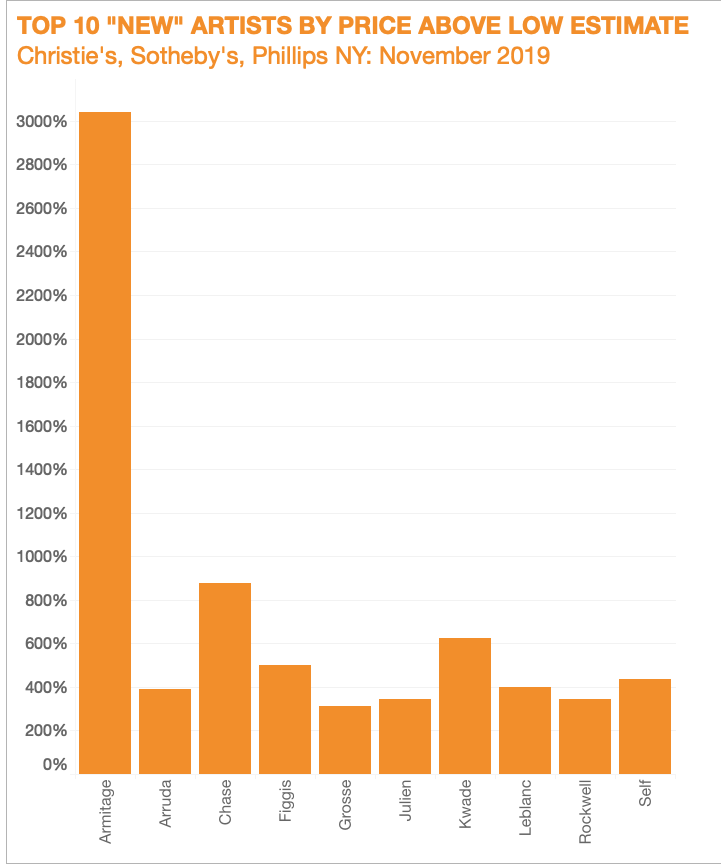Auctions
We Broke Down the Data From New York’s Fall Auctions. Here Are 3 Things They Reveal About Where the Art Market Is Headed
Consult our charts to learn which segments of the art market are growing—and which ones are shrinking quickly.

Consult our charts to learn which segments of the art market are growing—and which ones are shrinking quickly.

Tim Schneider &
Julia Halperin

With nearly 1,800 artworks offered across the Big Three auction houses’ main evening and day sales, New York’s fall auction week borders on sensory overload. To help make sense of the latest heaping helping of hammering, we used the data to zoom out to the big picture. Below are three important trends that rose to the top: one on prices (mid-priced works are doing better than trophies), one on genres (Imp-Mod is down, ultra-contemporary is up), and one on the new names who made noise on the block (two words: Michael Armitage).

© artnet Price Database 2019.
Ahead of last week’s auctions, there was much discussion about the absence of big-ticket lots. And indeed, sales for works over $10 million dropped 37 percent compared to last November, marking the lowest total over the six-year period we examined. But while masterpieces were in short supply, every other price bracket posted modest gains. The most substantial growth—7.6 percent—came in the $1 million-to-$10 million price bracket.
What it means: It’s a sign that in the absence of reliable star objects by the same old winners, auction houses are working to build up markets for artists with less of an auction track record but a heartier supply of strong material, like Alma Thomas and Charles White.

© artnet Price Database 2019.
The absence of big-ticket lots hit the Impressionist and Modern sector hardest. That genre suffered a 25 percent drop in total sales from last November. Postwar art remained relatively steady, dropping from $503 million to $501 million. On the other hand, the contemporary and ultra-contemporary categories (the latter refers to artists born after 1975) both posted gains—a sign that sectors with more readily available high-quality supply are continuing to grow. In fact, the ultra-contemporary segment posted its highest total over the past six years—a stunning 204 percent increase from last November’s sum.
What it means: Is this a sign that the art market, which for years appeared to be more interested in recovering overlooked talents from the past than pumping up the careers of new graduates with growth hormone, is becoming youth-obsessed again? Time will tell, but the numbers certainly point in that direction.

© artnet Price Database 2019.
While figurative painting by young artists, particularly work that deals with identity or the body, has been a subject of speculation in recent years, the best-performing auction debuts in this cycle seemed to move away from a single dominant trend, offering a more eclectic mix. We examined the 10 artists who appeared in this sales cycle for the first time and whose final prices outperformed their pre-sale estimates by the largest percentage.
Five of the 10—Michael Armitage, Jonathan Lyndon Chase, Genieve Figgis, Tschabalala Self, and Cheyenne Julien—are young figurative painters, which comes as little surprise. (Four of these five are also artists of color.) Meanwhile, the late Belgian op-art painter Walter Leblanc and the late wholesome American painter Norman Rockwell are both relatively old school, but reached a new audience through their inclusion in Phillips’s contemporary art sales. And the performance of Lucas Arruda, Alicja Kwade, and Katharina Grosse proves that appetite remains for abstract painting and sculpture, especially if the artists come with blue-chip gallery pedigree and a solid collector base.
What it means: The market is definitely hungry for the next hot young thing—as the reaction to Michael Armitage, the painter coming off a splashy debut at the Venice Biennale and a MoMA solo show, proves. But this November’s results also suggest that, when it comes to speculation, the dead can still dance, too.
Methodology: This article examines sales at the 10 major fine-art auctions (evening and day) held annually in early November at Christie’s, Sotheby’s, and Phillips New York, from 2014 through 2019. The “new” artists were defined as any whose work was consigned for the first time to either one of these 10 major sales or to their equivalents held annually in New York in May. All sales values are denominated in US dollars and include buyer’s premiums. Dollar values have not been adjusted for inflation. All data comes courtesy of the artnet Price Database and artnet Analytics Reports.